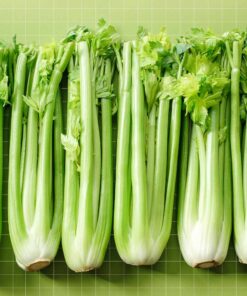How to Grow Celery from Seeds
Celery Seeds are a crisper, healthier vegetable that takes time to grow but is well worth the effort. Because of the long growing season, seed growing may be time-consuming with effort and patience. Nevertheless, where you have good conditions, it becomes feasible for you to have fresh celery in your own backyard.
| Number of Seeds | 100 seeds |
|---|---|
| Sowing month | Feb to Oct |
| Sowing temperature | 20-40C |
| Sun | minimum 3 hours |
| Harvest | 45-60 Days |
Starting Celery Seeds Inside
Celery seeds are small and slow to germinate and therefore need to be planted indoors 10 to 12 weeks prior to the last frost. Begin by filling a seed tray with a light, well-draining potting mix. Next, spread the seeds on the surface and gently press them into the soil. Do not cover them entirely since celery seeds require light to germinate.
Next, mist the soil with water and cover the tray with plastic wrap to maintain moisture. Place it in a warm spot, 70–75°F (21–24°C). The seeds will germinate in 2 to 3 weeks. Once they have germinated, remove the plastic and move the tray to a sunny window or under grow lights.
Celery Seeds Transplanting Celery Outdoors
Transplant the seedlings when they are 3 inches tall and the danger of frost has passed. Start by selecting a well-sunlit area with rich, draining soil. Compost should be added to the soil before planting to provide the soil with additional nutrients.
Then, dig holes into the ground 6 to 8 inches apart and simply drop each seedling into the holes. Water thoroughly after planting them so that they settle nicely. For moisture retention, spread mulch over the ground.
Celery Seeds Keeping Celery Plants Alive
Celery requires regular watering for the formation of fleshy stalks. The watering should be regular but never wet. Celery being a heavy feeder does appreciate two- or three-weekly fertilization with a balanced fertilizer.
To promote tall, narrow stalks, try blanching by wrapping the plant stems in newspaper or cardboard several weeks before harvest.
Celery Seeds Harvesting Celery
Celery takes 90 to 120 days to harvest. Use the outside stalks as you harvest, or dig up the whole plant by cutting it at the ground line. Fresh, homegrown celery is sweet and crunchy and is a great addition to salads, soups, and snacks.
This way, you can have tasty, homegrown celery fresh from your own garden!
| Color | Green |
|---|---|
| Germination Level | Easy |
| Growth Pattern | Up right Straight |
| Hybrid or Open Pollinated | Hybrid |
| Ideal location | Partial Sun |
| Origin Country | India |
Be the first to review “Celery Seeds ishtar Pack of 100 seeds” Cancel reply
You must be logged in to post a review.
FAQs
When to Transplant
Once seedling has 4 true leaf then cab be transplanted after Sunset without disturbing the roots
How to germinate from seeds
Fill pot 80% with soil and compost mix the top layer 20% spread cocopeat, then place seeds on top of cocopeat, then cover seeds with thin layer of cocopeat, Maintain moisture till germination
















Reviews
There are no reviews yet.